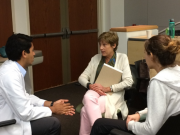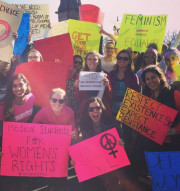Women account for almost half of all medical school graduates in the United States, yet they lag behind men in the higher ranks of academic medicine and in leadership roles, according to the Association of American Medical Colleges. This disparity increases even more so for women of color who represent 11% of full-time faculty and 3% of department chairs [1].
Stanford University recently published an article in their Spring issue of Stanford Medicine entitled, "Pursuing Parity," which highlights the barriers female faculty members have faced throughout their careers such as gender bias in recruitment and promotion practices and managing the stresses of work-life balance [2]. The article on female faculty was just one part in a larger series focused on the issue of sex, gender, and medicine.
Meanwhile, Northwestern University faculty have also been vocal in bringing attention to gender disparities in academic medicine. Last year, NU faculty members Drs. Angira Patel and Sarah Bauer penned an article which encourages female physicians to stand by their career and family choices and advocates for an open dialogue about the inequities that exist for women in medicine [3]. Both articles stress the importance of policies which support transparency, limit unconscious or implicit bias, and foster an inclusive culture and climate.
For further reading you may be interested in the following:
- Quota of Four – A historical perspective surrounding the first female graduates of Northwestern's medical school, penned by NU alum and science writer, Megan Thielking.
- Letter to a Young Female Physician – An perspective piece in the New England Journal of Medicine, written by Dr. Suzanne Koven, an assistant professor of medicine at Harvard Medical School.
The Women's Health Research Institute promotes the inclusion and advancement of women in science and medicine. The Institute has established several programs to promote the next generation of women in the basic and health sciences and to address the "leaky pipeline" in academia. More information on these programs can be found below:
References:
1. Association of American Medical Colleges, Analysis In Brief. 2016; 16(4).
2. Zonana, K. Pursuing Parity, Stanford Medicine. 2017; 34(2). 26-31, 44-45.
3. Patel and Bauer. Pulled by different forces, women in medicine need to stand by their career and family choices, Stat News. 2016.


 Students learn how to incorporate sexual health history into a routine exam.
Students learn how to incorporate sexual health history into a routine exam.  FSM-AMWA members participate in the Chicago Women's March on January 21st, 2017.
FSM-AMWA members participate in the Chicago Women's March on January 21st, 2017.